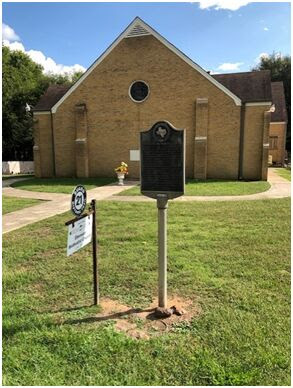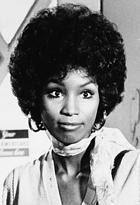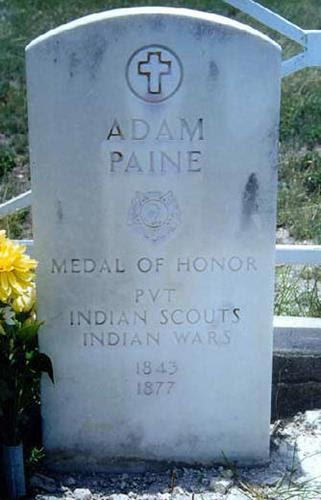Prairie View A&M University, a proud historically Black institution founded in 1876
TIPHC Newsletter
Oct. 10-16, 2021
To subscribe (it's free!), click here.
The TIPHC Newsletter is a weekly compendium of African American history topics relative to Texas, specifically, but nationally as well for Black history enthusiasts. However, if you're teaching or studying black history, the newsletter is also a useful tool for research, classroom discussions and assignments, and references. We welcome your feedback and submissions for any section of the newsletter. For more information, please contact Michael Hurd, TIPHC Director, at mdhurd@pvamu.edu or (936) 261-9836.

“To live is to suffer; to survive is to find some meaning in the suffering.”
- Roberta Flack, singer

Houston historian Patricia Smith Prather's "Texas Trailblazer" series, courtesy of the Texas Trailblazer Preservation Association.
Though his actual birth year has been debated, J. Vance Lewis was born in Louisiana shortly before or after the end of slavery. He earned a law degree from the University of Michigan in 1894 and practiced for several years in Chicago. He came to Houston in 1901 and established a thriving practice in Fourth Ward. Lewis was the first African American lawyer to win a case before a Harris County jury. (more)
Black History in the News

This Tuskegee Airman accomplished a lot. But nothing topped winning the 1st ‘Top Gun’ trophy
(airforcetimes.com) James Harvey doesn’t want to be known as the first Black fighter pilot to fly in Korean airspace. He doesn’t want to be known for his Distinguished Flying Cross or the 11 Air Medals he earned in combat. And he doesn’t want to be known for his time as a commander, a test pilot or an officer reporting to the head of NORAD. Harvey, one of the few members of the Tuskegee Airmen still living, wants to be remembered for an honor that eluded the public eye for nearly 50 years: winner of the first “Gunsmoke” aerial shooting competition in 1949. (more)
Photo: U.S. Air Force Capt. Alva Temple, 1st Lt. James Harvey, 1st Lt. Harry Stewart and 1st Lt. Halbert Alexander pose with their 1949 Weapons Meet trophy in May 1949 at the Flamingo Hotel in Las Vegas, Nev. (U.S. Air Force photo)

‘These are our ancestors’: Descendants of enslaved people are shifting plantation tourism
(washingtonpost.com) At three plantations in Charleston, S.C., Black descendants are connecting with their family’s history and helping reshape the narrative. The past two decades have seen a shift among plantation museums across the south. Previously, the majority of tours focused on the architecture of the main house, the landscapes and the economics of slavery. But today, a growing number of these sites are making efforts to confront slavery head-on, emphasizing the narratives of the enslaved and often requesting the help of their descendants. (more)
Photo: A sign honoring the enslaved Africans buried in the woods surrounding the area stands across the street from McLeod Plantation. (Gavin McIntyre for the Washington Post)

Understanding Black Southern Funeral Food Tradition
(blacksouthernbelle.com)
Photo Credit: Chantilly Lace Photography

Marshall History: The Buard Historic Trail and African-Americans in Marshall
(marshallnewsmessenger.com) The Historic Landmark Preservation Board of the City of Marshall established the Buard Historic Trail in 2007 as a 90-minute driving trail highlighting 28 sites to highlight African-American history in Marshall’s New Town Neighborhood. The New Town Neighborhood, a primary African-American neighborhood, is located on the southwest side of Marshall. By 1930, there were six African-American communities within the City of Marshall. The most prestigious was the New Town Neighborhood. (more)
Photo: Ebenezer United Methodist Church, 908 Whetstone St. in Marshall, Texas.
This Week in Texas Black History

Oct. 10 -- Singer and actress Teresa Graves died in a fire at her Hyde Park (Los Angeles) home on this day in 2002 at age 54. Graves, a Houston native, was a regular on “Rowan & Martin’s Laugh-In” comedy show in 1969 and 1970. She also starred in the television police drama “Get Christie Love” in 1974-75, making her the first black actress to have her own hour-long dramatic TV series.

Oct. 10 -- On this day in 1914, Ivory Joe Hunter, R&B singer and songwriter was born in Kirbyville. Hunter was a teenager when he began touring as a musician. His first of several hit songs was “I Almost Lost My Mind,” which topped the R&B charts in 1950 and later that year “I Need You So” reached number 2. In 1957, “Since I Met You Baby” reached No. 1 and “Empty Arms” reached No. 2. Later in his career, he turned to country and western music and regularly appeared at the Grand Old Opry. A prolific songwriter, it’s estimated that Hunter penned more than 7,000 songs. Elvis Presley recorded two of Hunter’s songs that made the Top 20, “My Wish Came True” and “Ain’t That Loving You Baby.” And, in 1970, Sonny James cover of “Since I Met You Baby” was No. 1 on the country charts. Hunter is honored as a music legend in the Museum of the Gulf Coast’s Music Hall of Fame in Port Arthur. A Texas Historical marker honoring Hunter was erected near Magnolia Springs in Jasper County in 2009.

Oct. 10 -- Milt Larkin, bandleader and self-taught jazz trumpeter, was born on this day in 1910 in Navasota. Larkin began playing trumpet at age 16 and only 10 years later formed his own band in Houston after playing with Chester Boone. Larkin’s group, known as “the last of the great Texas bands,” included saxophonists Illinois Jacquet and Arnett Cobb and was compared favorably with Jimmie Lunceford and Cab Calloway. His popularity grew in New York where he led house bands at the Apollo Theater and the Celebrity Club.

Oct. 10-- On this date in 1905 baseball hall of fame shortstop Willie “Devil” Wells was born in Austin. Wells starred in the Negro National League where he established an outstanding reputation with a lifetime batting average of .358 in games for which there are confirmed records. He was a clutch hitter and an extraordinary fielder called the "Shakespeare of Shortstops." Wells was selected eight times for the East-West Classic, the Negro Leagues' all-star game, including the first game in 1933 and the 1945 game, in which he played second base for the East and Jackie Robinson, then of the Kansas City Monarchs, played shortstop for the West. Growing up in Austin, he attended Anderson High School and Sam Huston College.

Oct. 11 -- On this day in 1930, Clifton Richardson founded and became editor/publisher of the Houston Defender, a weekly newspaper focusing on the city’s black community. Richardson had the same roles in 1919 with the Houston Informer. He was also a vocal supporter of civil rights and was a founding member of the Civic Betterment League (CBL) of Harris County and founding member and later president of Houston’s NAACP chapter.

Oct. 12 -- On this day in 1950, Herman A. Barnett, III, an Austin native, enrolled as a regular student of the University of Texas Medical Branch in Galveston becoming the school’s first black student. However, in the previous year, Barnett had been accepted to the school but as a student in Houston at Texas State University for Negroes (now Texas Southern University), attending UTMB under a contract program between the schools. The program was stopped after the Veterans Administration (Barnett’s tuition was covered by the GI Bill) refused to recognize the contract system and Barnett’s attorney threatened legal action. Barnett became a prominent surgeon and anesthesiologist and was a graduate of Huston College (now Huston-Tillotson University) in Austin. During WWII, he was a Tuskegee Airman (332nd Fighter Group) and in 1968, became the first African-American to serve on the Texas State Board of Medical Examiners. In 1973, he was the first black elected president of the Board of Trustees of the Houston Independent School District.

Oct. 12 -- Physician Monroe Alpheus Majors was born on this day in 1864 in Waco. Majors was also a civil rights leader and writer. He attended Tillotson College (now Huston-Tillotson University) in Austin, but graduated from Central Tennessee College in Nashville then enrolled at Meharry Medical College and graduated as salutatorian of his class in 1886. He was one of the founders of the Lone Star State Medical, Dental, and Pharmaceutical Association, one of the first medical societies in the country for black physicians. In 1888, fearing for his life after racist threats because of his influence in the community, he moved to Los Angeles and became the first black physician to practice medicine west of the Rocky Mountains. He returned to Waco in 1890 to practice medicine and serve as lecturer in hygiene and sanitation at Paul Quinn College, and also built and operated a hospital for blacks. As a writer, he published Noted Negro Women (1893), a book of biographies of prominent black women of the period, and in 1921 wrote First Steps and Nursery Rhymes, the first book of nursery rhymes written specifically for black children.

Oct. 12 -- On this day in 1919, Pearl Harbor hero Doris ("Dorie") Miller was born in Waco. Miller was a mess man aboard the USS West Virginia when the Japanese attacked on Dec. 7, 1941. Miller moved several wounded sailors to safety and then manned an anti-aircraft gun, for which he had no training, and fired at attacking planes. For his actions, Miller was the first African-American to be awarded the Navy’s second highest honor, the Navy Cross. (Note: Please see TIPHC Bookshelf for “Doris Miller, Pearl Harbor, and the Birth of the Civil Rights Movement.”)

Oct. 13 -- In 1875, on this day, Adam (or, “Adan”) Paine (1843-1877), a black Seminole, was awarded the Congressional Medal of Honor. Paine was a scout at Fort Duncan, Texas, and received the MOH for his actions during a battle at Quitaque Peak where he defended himself and four other scouts against several bands of Comanche Indians on September 26, 1874. Greatly outnumbered, the scouts fled, fighting as they went, though Paine held back to protect the others, allowing them to get away as he fired repeatedly at their pursuers. Payne’s horse was shot from under him, however, Paine continued to fight and eventually shot the rider of one horse, mounted the animal and made his escape. Thanks to his efforts during the engagement, all of the scouts survived. Paine’s commanding officer, Colonel Ranald S. Mackenzie, said that Paine “has more cool (and) daring than any scout I have ever known.”

Oct. 13 -- On this day in 1864 the Elm Creek Raid occurred, during which a band of several hundred Kiowa and Comanche Indians raided a settlement in the Elm Creek Valley (northwest of Dallas and South of Wichita Falls) where Britt Johnson, a ranch foreman and former slave, and his family lived. During the raid, Johnson’s son, Jubal, was among several settlers killed. Johnson’s wife, Mary, and two daughters were among the hostages taken into Indian Territory (Oklahoma). Johnson spent the next year traveling into the Territory and finally locating his family. Johnson worked with Comanche Chief Asa-Havey to pay a ransom and regain his family. The story of Johnson’s quest (fact or fiction) was the inspiration for Alan LeMay’s 1954 novel, The Searchers, which director John Ford would turn into a movie of the same name in 1956 starring John Wayne.

Oct. 15 -- Houstonian Emmett Scott was appointed Special Assistant to the Secretary of War, Newton Baker, on this day in 1917 as a liaison between black soldiers and the War Department amid rising racial tensions in the country. Among Scott’s accomplishments in that role were:
- The formation of a Speakers’ Bureau, or “Committee of One Hundred,” to enlighten black Americans on the war aims of the government.
- The continuance of training camps for black officers and the increase in their number and increasing their scope of training.
- Betterment of the general conditions in the camps where blacks were stationed in large numbers, and positive steps to reduce friction between
- The opening of every branch of the military service to colored men, on equal terms with all others, and the commissioning of many colored men as
officers in the Medical Corps. - A report about conditions facing African-Americans during the period, which were published in 1919 as The American Negro in the World War.
TIPHC Bookshelf
Football at Historically Black Colleges and Universities in Texas
By Rob Fink
Although others have examined specific institutions, time periods, and rivalries in black college football, this book is the first to feature a broad narrative encompassing an entire state. This wide field of play affords the opportunity to explore the motivations and contexts for establishing football teams at historically black colleges and universities; the institutional and community purposes served by athletic programs; and how these efforts changed over time in response to changes in sport, higher education, and society. (more)
Black History Timeline

1963
On August 27th of this year, educator, journalist, scholar, social critic, and activist William Edward Burghardt DuBois died in Accra, Ghana at age 95. In 1895, DuBois became the first African American to earn a Ph.D. at Harvard. In 1903, DuBois published a groundbreaking collection of essays, The Souls of Black Folk, which challenged the civil rights strategies of black leaders like Booker T. Washington while inspiring a cadre of young black activist scholars to use their work to combat racial oppression. In 1909, DuBois became a co-founder of the National Association for the Advancement of Colored People (NAACP) and served as the editor of its magazine, The Crisis, until 1934. (more)
Submissions wanted
Historians, scholars, students, lend us your…writings. Help us produce the most comprehensive documentation ever undertaken for the African American experience in Texas. We encourage you to contribute items about people, places, events, issues, politics/legislation, sports, entertainment, religion, etc., as general entries or essays for publishing on the TIPHC website or here in the newsletter. Our documentation is wide-ranging and diverse, and you may research and write about the subject of your interest. However, all topics must be approved by the TIPHC before beginning your research/writing.
For more information, please contact Michael Hurd, TIPHC director, at mdhurd@pvamu.edu.


No comments:
Post a Comment